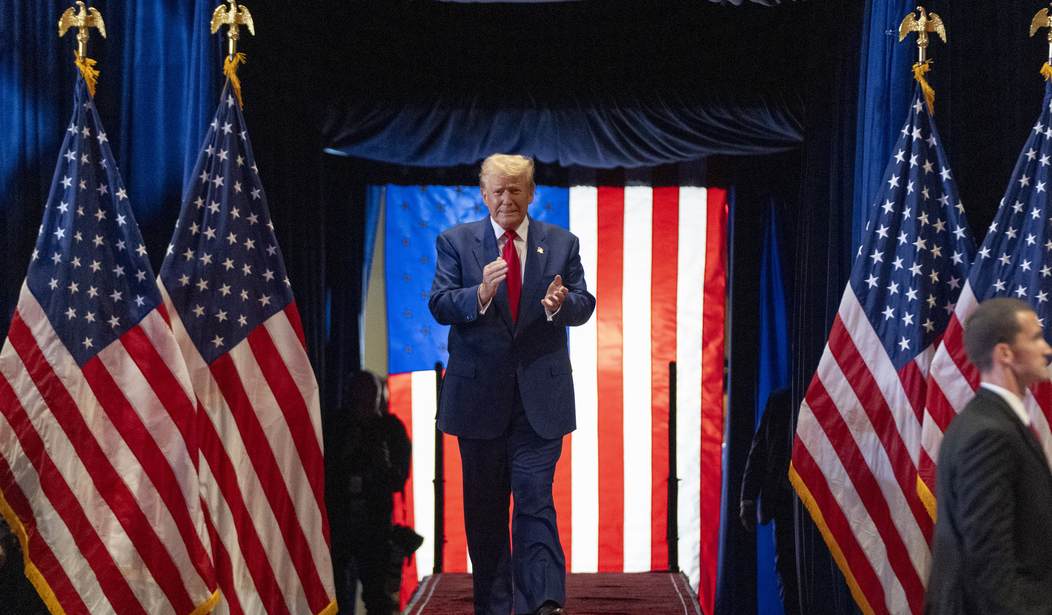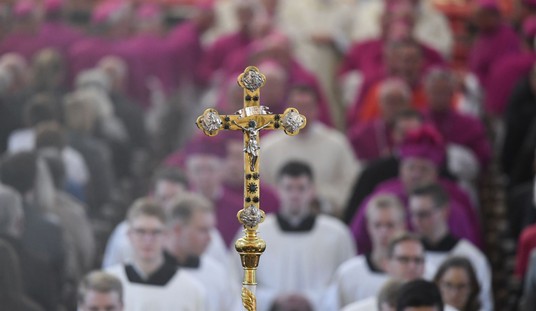We're just about six weeks away from the election, and the polls are continuing to pour in, especially when it comes to the key swing states that are likely to decide the outcome. It still looks to be a close and competitive race, one that's really down to the wire, though Vice President Kamala Harris doesn't look to be performing as well as she needs to be. Will former and potentially future President Donald Trump outperform the polls, again? It's certainly possible. Further, there's polls where the good news for Trump is undeniable, with even Democratic allies in the mainstream media admitting as much.
The latest poll from The New York Times/Siena College focused on the swing states of Arizona, Georgia, and North Carolina. Among likely voters, Trump leads by 50-45 percent in Arizona, by 49-45 percent in Georgia, and by 49-47 percent in North Carolina.
The poll surveyed 713 registered voters in Arizona with a margin of error of plus or minus 4.4 percentage points; 682 registered voters in Georgia with an MOE of plus or minus 4.6 percentage points; and 682 registered voters in North Carolina with an MOE of plus or minus 4.2 percentage points. There were 2,077 likely voters total with an MOE of plus or minus 2.5 percentage points.
🇺🇲 2024 GE: NYT/@SienaResearch
— InteractivePolls (@IAPolls2022) September 23, 2024
ARIZONA
🟥 Trump: 50% (+5)
🟦 Harris: 45%
Last poll (8/15) - 🔵 Harris +5
——
NORTH CAROLINA
🟥 Trump: 49% (+2)
🟦 Harris: 47%
Last poll - 🔵 Harris +2
——
GEORGIA
🟥 Trump: 49% (+4)
🟦 Harris: 45%
Last poll - 🔴 Trump +4
——
#1 (3.0/3.0) |… pic.twitter.com/oItjnaKpFJ
"Trump Shows Signs of Strength in Sun Belt Battlegrounds, Polls Find," the headline for the write-up from The New York Times reads. "Slight gains for Trump in Sun Belt as race remains tight, new polls show," a headline from POLITICO also acknowledged.
"The polls of these three states, taken from Sept. 17 to 21, presented further evidence that in a sharply divided nation, the presidential contest is shaping up to be one of the tightest in history," the write-up from The New York Times notes.
Recommended
There's more hope for Trump beyond the numbers:
Voters across the Sun Belt say that Donald J. Trump improved their lives when he was president — and worry that a Kamala Harris White House would not — setting the stage for an extraordinarily competitive contest in three key states, according to the latest polls from The New York Times and Siena College.
...
The polls found that voters in this part of the country were worried about their own future and the future of the nation, suggesting that Mr. Trump’s dark campaign rhetoric — “Our country is being lost, we’re a failing nation,” he said in the debate — could be resonating with some voters. A plurality said the nation’s problems were so bad that it was in danger of failing. Republicans were much more likely to hold that unsettled view of the future than Democrats, 72 percent to 16 percent.
...
As in nearly every state and national poll conducted this year by Times/Siena, a plurality of voters — 31 percent — identified inflation or the economy as the top issue in deciding their vote. And 55 percent of these Sun Belt respondents said Mr. Trump would do a better job managing it, compared with 42 percent for Ms. Harris.
When it comes to top issues and the sentiments for the country that benefit Trump, 63 percent of likely voters in all three states said the country is going in the "wrong direction," compared to the 27 percent who believe it's on the "right track."
Not only do 26 percent of likely voters in those three states say that "The economy (including jobs and the stock market)," is their top issue, which tends to be good news for Trump, but by 50-46 percent, respondents believe Trump is the candidate who will "do a better job of handling the issue you think is most important?"
On the economy, by 55-42 percent, likely voters in the three states trust Trump more than Harris. Trump leads by 54-43 percent on immigration, and Harris leads by 53-41 percent on abortion. Trump and Harris are also tied at 47 percent each when it comes to which candidate the likely voters trust more on democracy, which is bad news for the Democratic nominee, considering how much she and her party to focus on Trump being a supposed "threat."
While the write-up misses the chance to make clear that Trump regards abortion as a states rights issue, there is a note about how he's closed the wide gap Harris has on the issue.
The write-up notes that Trump "has closed the gap slightly with Ms. Harris on which candidate would do a better job on abortion rights, mostly by improving his standing on the issue with Republicans by a few points."
Democrats, including but not limited to the Harris-Walz campaign, have made it a habit to lie and mislead with claims that Trump supports a national abortion ban. Meanwhile, the Harris-Walz campaign supports abortion up until birth for any reason, with Harris and her running mate, Minnesota's Gov. Tim Walz also opposing mandating medical care be given to babies born alive from abortions.
It's not just the issues that are noteworthy. Among likely voters in those three states, 45 percent say Trump policies "helped" people like them, while 34 percent said they "hurt" people like them. Meanwhile, a plurality in those three states say that Harris' policies would "hurt" people like them, 42-37 percent.
As a chart included in the write-up highlights, Independents look to be of the same mind, as 43 percent said Trump's policies "helped" people like them, while 30 percent said they "hurt" people like them. Forty-two percent of Independents worry that Harris' policies would "hurt" people like them, while 30 percent believe they'll "help" people like them.
As the poll also highlighted:
But with less than two months to go until Election Day, Ms. Harris has shown mixed success in selling her candidacy, at least in these three states. And the jubilant scenes from her rallies are not translating to some voters, who remain unpersuaded and unhappy. In one sign of that, women and young voters, who historically have supported Democratic candidates, are divided over whether Mr. Trump’s policies or Ms. Harris’s policies would be better for them.
Overall, 45 percent of respondents said Mr. Trump’s policies as president had helped them, and 34 percent said they had hurt them. “With Trump, he did what he said he was going to do," said Erik Kerr, 55, a landscaper in Tucson, Ariz., who said he planned to vote for Mr. Trump.
...
The polls found that 42 percent of likely voters said Ms. Harris’s policies would hurt them, compared with 37 percent who said they would help them.
For all of this talk about a supposed "boost" for Harris following the ABC News debate earlier this month, and the "enthusiasm" for Harris mentioned in the write-up, one common theme is that it doesn't look to be as effective as the Harris campaign needs it to be. A chart included by The New York Times even shows Trump going up in these states, according to the post-debate margin. Further, it was always a given that there would be such a boost for Harris, given that she's not President Joe Biden, who was forced out of the race in July by his fellow Democrats, less than a month after that disastrous debate performance against Trump on June 27.
One particularly telling detail about the poll results in Trump's favor is that it's a 49-47 percent sample when it comes to whether respondents voted for Biden or Trump in 2020. In Arizona, however, the sampling was 49-46 percent when it comes to respondents who voted for Trump over Biden.
Trump also has a slight edge on favorable ratings over Harris. Forty-seven percent have a favorable view of Trump across the three states, while 50 percent have an unfavorable view. Meanwhile, 46 percent have a favorable view of Harris, while 51 percent have an unfavorable view.
The New York Times mentioned other polls to show that Trump is up by +2 in Arizona after the debate, by +2 in Georgia, and even in North Carolina.
With those polls included in the averages, RealClearPolling shows that Trump currently leads in Arizona by +2.2, in Georgia by +2.0, and in North Carolina by +0.4. RCP also shows that Harris leads by +2.2 at the national level, but that Trump has a narrow edge of +0.1 in the battleground states.
Nate Silver mentioned the poll in his bulletin for Monday. "On balance, a good day of polling for Donald Trump, but I was surprised that the forecast didn’t move more toward him. A strong poll for Kamala Harris in Wisconsin went a long way toward offsetting a trio of NYT/Siena polls in Georgia, Arizona and North Carolina that were good for Trump," he mentioned.
His margin shows an R+1.5 in Arizona, R+1.3 in Georgia, and +0.4 in North Carolina. All of those margins have improved for the Republicans since last month, and since last week for Arizona and Georgia, while they're even in North Carolina.
Today's update. A little surprised that the model didn't move more toward Trump, but a poor series of NYT polls for Harris in GA, AZ and NC was offset by a strong poll for her in Wisconsin.https://t.co/vsGVG189Sa
— Nate Silver (@NateSilver538) September 23, 2024
Speaking about concerns with Trump overperforming, Bob Hoge at our sister site of RedState had a great roundup earlier on Monday of those Democrats and the panic they're experiencing.
Nick Arama, also of RedState, mentioned the poll in his write-up for Monday afternoon, noting there's a tight race per polling from Emerson College/The Hill as well.
NEW: Emerson College/The Hill poll finds Trump with edge in most swing states, but race remains tight
— Election Wizard (@ElectionWiz) September 23, 2024
GA:
Trump 50
Harris 47
AZ:
Trump 49
Harris 48
WI:
Trump 49
Harris 48
PA:
Trump 48
Harris 47
NV:
Trump 48
Harris 48
NC
Trump 49
Harris 48
MI
Trump 47
Harris 49
9/15-9/18

























